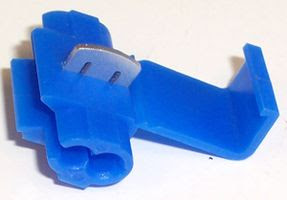The English version of this article is here
At mixanikos365 We take for granted a general rule that:
ELOT HD384 says about the choice of means of connection of the pipelines: 1) By torsion

2) Electrical Terminal
Made of polypropylene and galvanized steel alloy. Operating temperature: 85°C
We find them in sections:
- single stranded cable = Caps
- polyclonal cable = pressed terminals
Also the multi-core cables are joined with crimped terminals and in the panel connections

or a strange way of twisting for the very patient
2) Electrical Terminal
Made of polypropylene and galvanized steel alloy. Operating temperature: 85°C
We find them in sections:
- 0.75mm2-2.5mm2
- 2.5mm2-4mm2
- 6mm2
- 10mm2
- 16mm2
- 25mm2
3) CAPS - COVERS (Screw)
Cable caps (CAPS) are manufactured from thermoplastic raw material with an internal brass spiral. They are used in cable junctions (cable joint), fast (screwed), providing security (insulation on the outside) and high conductivity on the inside.
Their application and operating temperatures are from -20°C to +80°C.
We find them in sections:
Their application and operating temperatures are from -20°C to +80°C.
We find them in sections:
- 1.5 mm2
- 2.5mm2
- 4mm2 6mm2 _
- 10mm2
4) KOYMPOMATA - COVERS (Pressed)

CAPS clasps are made of thermoplastic raw material with an internal metal conduit. They are used in cable junctions (cable joint), fast (press), providing safety (insulation on the outside) and high conductivity on the inside.
Their application and operating temperatures are from -20°C to +80°C.
They are available in different sizes according to the number of cables they will accept and according to the table below:
Cable joint protection-CAPS 3X2.5mm Cable joint protection-CAPS 4X2.5mm Cable joint protection-CAPS 5X2.5mm
Their application and operating temperatures are from -20°C to +80°C.
They are available in different sizes according to the number of cables they will accept and according to the table below:
Cable joint protection-CAPS 3X2.5mm Cable joint protection-CAPS 4X2.5mm Cable joint protection-CAPS 5X2.5mm
5) Quick splice connector

6) Wago connectors
7) Soldering iron and tin
The most classic way and at the same time the most 'difficult', if we can call it difficult, is the classic method with the soldering iron and tin.
The most classic way and at the same time the most 'difficult', if we can call it difficult, is the classic method with the soldering iron and tin.
Procedure
See another innovative way of gluing ducts
8) BUT SPLICES
Reblog https://oaedhlectrologoi.blogspot.com/2016/12/blog-post_7.html
We strip the cable from its outer casing and then strip the inner cables as needed. Place the cables on the soldering base (if we have one) for easier soldering. We open the soldering iron and wait 2-3 minutes for it to reach the appropriate temperature. away from the solder to avoid inhaling the fumes. Put a thin layer of tin on the nose for best results. Place the soldering iron on the bottom of each wire so it touches and rest the tin on top. It will slowly start to melt the tin and move it along the entire length of the cable, so that the bonding becomes uniform. We insulate each cable individually with insulating tape, and at the end we insulate the cables as a whole. It is good to use insulating tape of a different color to know at which point the cable has a problem so that we do not press it too much there. We can, of course, if we are sure of the result, use the same color of tape as the cable to make the bonding invisible. If we want, instead of the classic insulating tape, we can use heat-shrinkable macaroni (a kind of plastic casing that we pass over the cable, which if heated shrinks and closes airtight.)
See another innovative way of gluing ducts
8) BUT SPLICES
Materials
Wire stripper Butt Splices Special pliers Hot air stove (or strong hair dryer)
Wire stripper Butt Splices Special pliers Hot air stove (or strong hair dryer)
Procedure
We strip the cable from its outer casing and then strip the inner cables as necessary. Cut the bare cables to half the length of the inner connector.
We put one part on one end and the other part on the other end. We press the connector on the metal part with the special pliers, until the connection becomes stable. With the fireplace or the hair dryer, heat the connector until it starts to shrink plastic casing and make an airtight connection. For a better result we can pass the cable with insulating tape or with heat-shrinkable pasta
We strip the cable from its outer casing and then strip the inner cables as necessary. Cut the bare cables to half the length of the inner connector.
We put one part on one end and the other part on the other end. We press the connector on the metal part with the special pliers, until the connection becomes stable. With the fireplace or the hair dryer, heat the connector until it starts to shrink plastic casing and make an airtight connection. For a better result we can pass the cable with insulating tape or with heat-shrinkable pasta
In the following video you can watch the overload behavior of some of the above pipeline connection materials.
9) Heat-shrinkable or heat-shrinkable
To thank the ELECTRICAL SCIENTISTS of the 1st EPAS OAED THESSALONIKI for the amazing technological content and the wonderful articles they publish on their blog.























